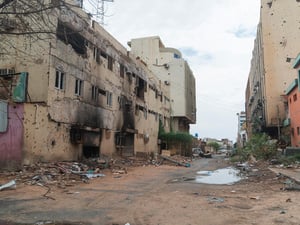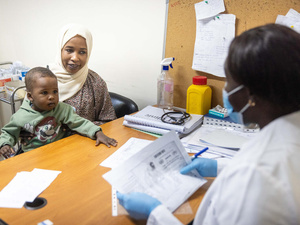Libyans flee fighting in west into Tunisia
Libyans flee fighting in west into Tunisia
UNHCR is seeing a growing number of Libyan refugees arriving in Tunisia from Libya's Western Mountains regions. This past weekend, some 6,000 Libyan nationals arrived in the Dehiba area of southern Tunisia. Overall, we estimate that 10,000 Libyans have crossed into this area over the past 10 days.
Most of the arrivals are families coming from the town of Nalut, some 50 kilometres from the Tunisian border. They told our staff that the Western Mountains area has been effectively under siege by government forces for a month and that the pressure on the civilian population has been increasing daily. Many of the new arrivals said they fled their homes fearing the fighting and shelling which has intensified significantly over the weekend. Reportedly, the conflict was moving closer to Nalut. From the Dehiba area, pillars of black smoke could be seen and loud explosions heard inside Libya on Monday.
Refugees also told UNHCR's team it took them about four to five hours to travel by car on winding mountain roads before they reached safety in Tunisia. In normal circumstances a journey form Nalut to Tunisia takes less than an hour. Once in Tunisia, these refugees approach the authorities at the official Dehiba border crossing to register their entry and legalize their stay.
The border town of Dehiba is now teeming with Libyan refugees and the number of Libyan cars has tripled over the past few days. Most of the newly arrived families (average family size is six people) have found shelter in local communities or with host families. Some are also staying in communal buildings or in one of the three camps set up by local authorities, the UAE Red Crescent and UNHCR.
As of this morning our camp in Remada was sheltering nearly 1,000 people and more tents are being put up to meet the growing need for shelter. Water, latrines, showers and electricity have been installed.
Meanwhile, in eastern Libya, a ship which arrived from Misrata to Benghazi on Saturday brought among its hundreds of passengers a group of 22 Iraqi families - refugees and asylum seekers who described to our team a terrifying situation in Misrata with rockets and shells regularly hitting residential areas of the city. The Iraqis praised Libyan communities for sharing their food, water and homes with them for several weeks, and most of all for accompanying them to the harbour to take the ship that would evacuate them to safety while the bombardment was taking place. Iraqis also said that they did not want to leave their Libyan hosts, but that the situation has deteriorated too much for them to stay in Misrata. They were extremely worried about the impact of yet another conflict on their children.
In Benghazi, the local authorities have registered some 35,000 internally displaced people (IDPs). We estimate the number to be closer to 100,000 as many residents of nearby Ajdabiyya are thought to have left for Benghazi. Most of the Libyan IDPs are staying with host families. Some 6,000 live in several settlements in the city. Additional pockets of IDPs have been identified along the coast from Benghazi to Tobruk. We are sending a team this week to deliver assistance to these displaced populations.
The recent surge in the numbers of refugees and others displaced by the fighting in Libya is adding to the strains for humanitarian agencies, which are critically short of funds. Given the increasingly protracted nature of the unrest in Libya, unless funding is provided urgently, a number of protection and assistance programmes will have to be scaled back along the border areas and inside Libya.
For further information on this topic, please contact:
- On the Egyptian border: Helene Caux on mobile: +201 294 66 378
- On the Tunisian border: Firas Kayal on mobile +216 508 561 99
- In Geneva: Andrej Mahecic on mobile +41 79 200 7617







